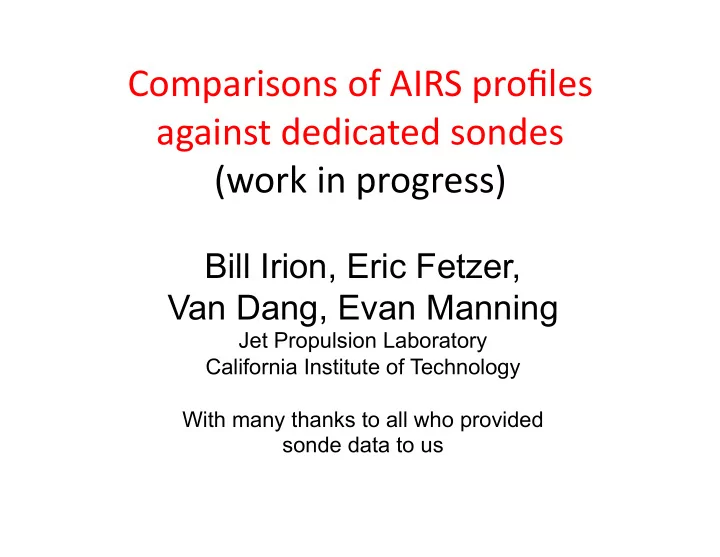

Comparisons of AIRS profiles against dedicated sondes (work in progress) Bill Irion, Eric Fetzer, Van Dang, Evan Manning Jet Propulsion Laboratory California Institute of Technology With many thanks to all who provided sonde data to us
Sonde data characteris<cs • ~880 sondes • ~7400 AIRS matchups within 3 hrs and 100 km
Modus operandi AIRS matchup data ‐ profiles Sonde profiles + metadata ‐ averaging kernels ‐ first guesses ‐ qual flags Matched profiles + metadata on AIRS support grid Filtering Loca<on + Qual Flags + Season + Clouds + etc Average results
AIRS –Sonde comparisons made • L2 result compared to sonde profile interpolated to AIRS support grid • By level if temperature • By slab column if gas • Init profile to sonde – How good (or bad) was our first guess • L2 to “Kerned” sonde profile: ˆ x • Sonde profile mul<plied by averaging kernel: ˆ x = x init + A ( x sonde − x init ) • This is what AIRS “should have seen,” given its sensi<vity and ver<cal resolu<on
# of Beltsville Biak Chesapeake Hanoi matchups “Unkerned” “Kerned” Initial Sample results Heredia Rico SGP Sodonkyl All qual_temp flags ≤ 1 2 hr, 100 km matchup range Only one AIRS observa<on per sonde added to average RMS
Heredia, Costa Rica Temperature profile comparison by season Only one AIRS observa<on per sonde added to average All temperature qual flags <= 1, within 100 km, 2 hrs # of matchups SON “Unkerned” MAM DJF JJA “Kerned” Initial RMS
Comparison for Chesapeake SON season by cloud frac<on One‐to‐one matchup, all temperature qual flags <= 1, within 100 km, 2 hrs 0 -25% 25-50% 50-75% > 75%
Further work • Tes<ng & debugging • Quality control for sondes – E.g., handling data dropouts • Water vapor (in progress), ozone • Valida<on against different seasons, cloud condi<ons etc. • Valida<on against different climate regimes • Results to be used in V5 valida<on report
Baijun Tian 1,2 V. Dang 2 , F. Irion 2 , E. Fetzer 2 , J. Teixera 2 , C. Ao 2 , B. Wilson 2 , G. Manipon 2 1 Joint Institute for Regional Earth System Science and Engineering (JIFRESSE), UCLA 2 Jet Propulsion Laboratory (JPL), California Institute of Technology (Caltech) AIRS Science Team Meeting, Oct 2008, Greenbelt, MD 9
1. The upper troposphere and lower stratosphere (UT/LS) is the important layer responsible for the troposphere- stratosphere exchange. 2. Accurate knowledge of tropopause temperature, pressure and height is very important for detecting the global climate change. To examine the ability of AIRS temperature retrieval to delineate the tropopause. 10
< 100 km, < 2 hr Black Squares - GPS; Red Asterisks - AIRS 11
12
13
1. AIRS can roughly capture the tropopause with an error of maybe 20hPa although detailed comparisons need to be done. 2. There are significant differences between AIRS and GPS temperature profiles (2-4K) especially near the tropopause. 3. There is a strong correlation between AIRS and ECMWF temperature profile errors relative to GPS.
Recommend
More recommend